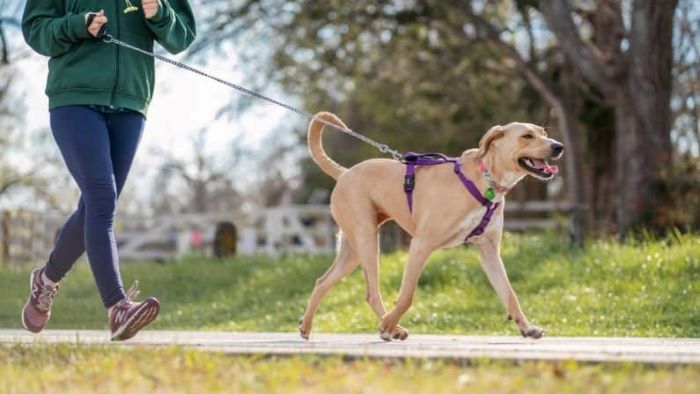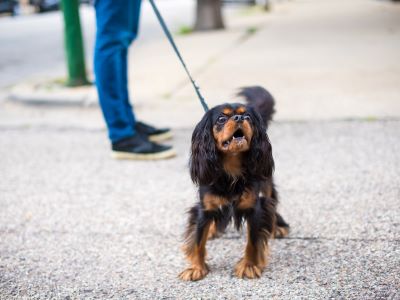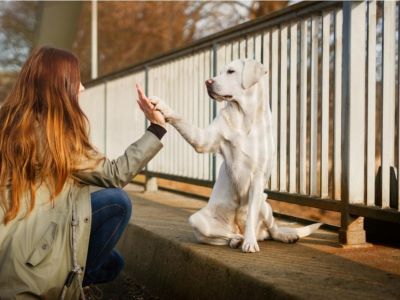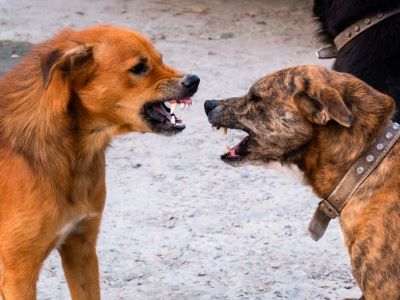Well, if you are here because you too have a reactive dog 🐶 who frustrates you during every walk then congratulations! It’s time to get rid of it (the behaviour not the dog!). If you have a reactive dog, you know how stressful and challenging it can be to walk them.

For those who don’t know, a reactive dog is one that barks, lunges, growls or snaps at other dogs, people or stimuli when on a leash. This behaviour can be caused by fear, frustration, excitement or lack of socialization. It can also put you and your dog at risk of injury or legal trouble.
But don’t despair. Walking a reactive dog 🐶 doesn’t have to be a nightmare. With proper training and patience, you can help your dog overcome their reactivity and enjoy walking with them. Let us know how to walk a reactive dog.
Behaviours of a Reactive Dog
Many people mistake reactive behaviour for aggressive ones. But, both are different.[1] Aggressive behaviour is about creating distance from something. It can be associated with fear or pain. If your dog is possessive about you or his favourite toy, then he will become aggressive when they feel unsafe.
“Aggression may be defined as any threat or harmful behaviour directed toward another individual or group. It may be displayed as an intent to avoid the further escalation of conflict or with the intent to cause physical or emotional harm to another individual.“, confirms Kenneth Martin and Lynn Buzhardt at VCA Hospitals.
Your dog may also show signs of reactivity through body language like raised hackles or biting at the leash, so wearing dog walking gloves can help protect your hands.
On the other hand, reactive dogs are triggered by a particular person, object or behaviour. For instance, your dog 🐕 will walk calmly but once he sees a cyclist or another dog, he suddenly starts whining or barking. This triggered behaviour of a dog is known as reactive behaviour.
Sometimes, the reactive behaviour in dogs is engaging. The dog sometimes starts to bark and thrust out of frustration at not being able to get to that person or thing right now. The triggers play an important role for a reactive dog.
Some signs that your dog is triggered:
- Bark and lunge
- Cower and hide
- Make quick turns
- Shake/tremble
- Whine
- Lift one paw
- Yawn when not sleepy
As a paw parent, you can’t completely eradicate all the objects or persons that trigger the dog. It’s quite impossible. Thus, it is your responsibility to teach your dog 🐶 how to handle and ignore triggers while walking.

The same goes for other dogs. If your Fido is not comfortable around other dogs during regular walks, you should train him for socialization. Your furry friend should deal with the triggers and make the walk a fun experience.
How to Walk a Reactive Dog?
An important consideration when walking a reactive dog is how long the walks should be. Walking for too long can overstimulate and stress out a reactive dog. On the other hand, too short a walk may not provide enough mental and physical exercise. So how long should I walk my dog? The appropriate duration depends on your dog’s age, health, and temperament.
It is paramount to train your dog in certain behaviours. One of them is walking peacefully while ignoring the triggers. Dogs should adapt to the environment around them positively. This will not only benefit him but help you to enjoy the walking sessions with your dog. A reactive dog 🐶 often causes trouble and frustration to their owners.
You might always be worried about taking your reactive dog out for a walk. Even on a leash, it would be difficult to handle such dogs. There is always a fear that reactive dogs will run away, following any trigger. Therefore, you should know how to walk a reactive dog.
1. Turn Triggers Into a Positive Experience
If your dog is often triggered by other dogs, cars, cycles or people, then you should always try praising your dog even for a slight behaviour modification.[2] For this, you should carry a handful of treats while taking your dog for a walk. Whenever any trigger passes by and your dog 🐶 remains calm, reward him with treats and praises.👏
When you’re out on your walk, as you see another dog approaching, wait until your dog notices them. When he does, get his attention and reward. Try to communicate with him that nothing bad will happen. If your dog remains calm while in the sight of another dog feed him treats 🍖 and praise continuously.
2. Accepting Failures
Sometimes, it would happen that the dog becomes overly whelmed and starts barking on his trigger. If you can’t control the dog, this means that you are very fast with the training. Step back and let the dog 🐶 learn at his own pace. Keep the training simple and slow. Don’t rush your dog.
Simply add more distance and repeat. You should never discourage your dog or punish him. Rather use positive reinforcement 💡 to accept accidents. Failure is always going to be a part of training, but it also helps us learn to improvise.
As mentioned by Erika Lessa at petMD, “Compared with other methods, positive reinforcement strengthens behaviour, builds trusting relationships between pet parents and their animal companions, and protects the behavioural health of pets.“
3. Keep Walks Unpredictable
Keeping the walks unpredictable will help the dog to focus only on walking rather than sniffing around and exploring the surroundings. You can make the walking fun by changing pace, changing directions are asking the dog to walk between your legs.

You can also get your pup’s favourite toy or a chew toy 🧸 to get him focused during the walk. Moreover, exercising in an unpredictable way where your dog is completely unaware of the next step is a great exercise to gain his interest and focus.
4. Avoid What Cannot Be Won
You are a pet owner and not a behaviourist, a perfectly trained and expert handler. Thus, it is obvious that you too are learning with your dog. When you encounter any situation while walking which cannot be handled, just ignore it.
Avoidance is just a way to keep things under control when you’re not feeling confident about confronting the situation. In such a situation, your as well as your dog’s safety should be something to prioritize.
5. Consult A Dog Behaviourist
As mentioned, dog behaviourists are well-trained and skilled in training dogs. If your dog is very reactive and is triggered by even usual objects, then you may consult a dog behaviourist. He will understand the needs and preferences of your dog 🐶 and come up with some simple solutions to get rid of the reactive behaviour of your dog.
Can Dog Reactivity Get Better?
Well, you must have experienced embarrassing moments like your dog suddenly pulls on the leash and starts barking while you are having a word with your friend. Yes, many owners of reactive dogs do! But, it is possible to get the reactivity better.

With proper training and efficient tools, you can correct the reactive behaviour of your dog. Again, one size never fits all. Thus, you better observe your dog 🐶, note down his triggers and work on them. With enough quality, you can always reinforce the behaviour you want.
FAQs
Is it OK to not walk a reactive dog?
Exercising your dog is important for his physical and mental health whether your dog is reactive or not. Said so, walking is the best form of exercise, not only does it help physically but mentally stimulates the dog. Walking is also necessary to promote potty training. Thus, it is important to walk a reactive dog too.
Where is the best place to walk a reactive dog?
Walk in areas where you are sure of other dogs being leashed. Some great choices are the dog training classes and neighbourhoods close to your house so that the dog is never a stranger. You can also walk the dog in nearby parks, avoiding the peak hours.
How do I train my dog not to react to other dogs?
You should first teach your dog to respond to his name. By doing so you will train him to redirect to you no matter what. Initially, avoid going to places with many dogs like a dog park. Slowly introduce to one or two dogs and practice socialization with them. Use a long leash and avoid pulling on it.
How to Walk a Reactive Dog? — An Overview
Walking a reactive dog can be hard, but it’s not impossible. By following some tips and techniques, you can make walking with your dog more enjoyable and less stressful. You can help your dog become more confident, calm and well-behaved on walks.
Remember, walking a reactive dog is not a quick fix. It takes time, consistency and dedication to see results. Don’t give up on your dog or yourself. Celebrate every small improvement and keep working on it. Your dog will thank you for it. Happy walking! 🐾
It’s important not to give up on walking your reactive dog. The consequences of not walking your dog can be serious check out our guide on what happens if you don’t walk your dog. With time and training, you can help your dog become better on leash.
References:
- Rakosky, E., DVM. (2022). What Is Aggression? Dog Reactivity vs. Dog Aggression. American Kennel Club.
- Managing reactive behaviour. (2023, May 5). Cornell University College of Veterinary Medicine from Cornell University.



